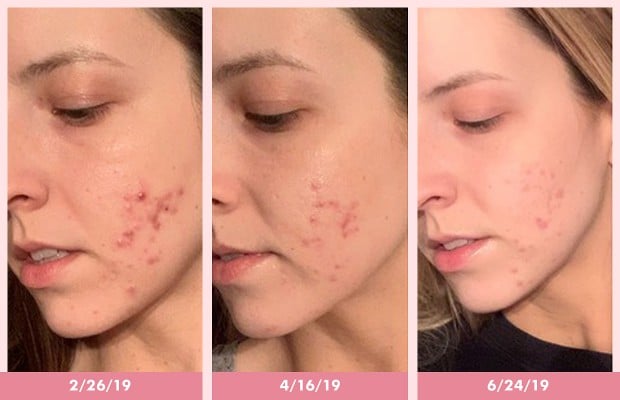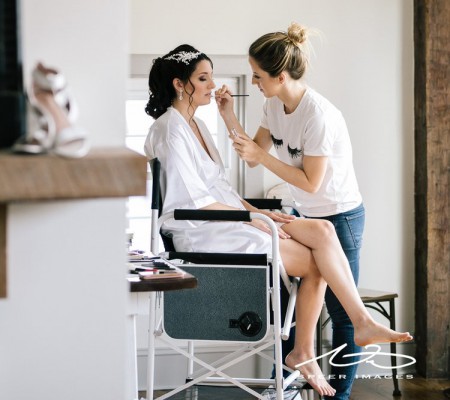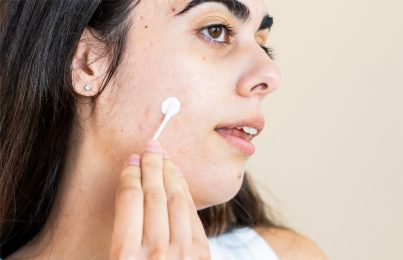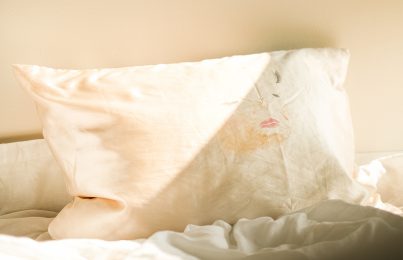Updated 11/10/20 Meet Ashley Landry! Ashley is a makeup artist from New Jersey who learned how to expertly cover acne after she started experiencing breakouts herself. I first met Ashley when she reached out via email to share the amazing results she’d gotten by using our products. After that, we set up a call so I could learn more about her skincare journey. As a makeup artist, Ashley understands the inherent relationship between good makeup and proper skincare. She struggled with breakouts for over a year before finally finding a routine that helped clear her skin.
“At my lowest point, I was getting two new breakouts every day,” Ashley said. “I hated the way zits made my skin look when I put on makeup, to the point where I didn’t want to leave the house. The acne was affecting me so much and started to break me down.”
While Ashley has since cleared up most of her breakouts (more on that in a minute!), finding the best makeup to cover her acne allowed her to feel more confident in the meantime. Ashley kindly took the time to talk with me about her journey so I could pass along some of her wisdom to my readers. I loved hearing Ashley’s story and learning some new makeup tips from her—hopefully you will too!
How a Makeup Artist With Acne Cleared Her Skin
During our call, I asked Ashley a few questions about her breakouts to better understand what had gotten her to this point. We spoke about acne treatments she’d tried (including microneedling for acne scars), the routine that finally cleared her skin and which Renée Rouleau product she considers her holy grail.
Renée Rouleau: When did you first start experiencing breakouts?
Ashley Landry: “I started getting regular breakouts about a year ago. It was the first full year of my business, so I think stress was definitely a factor. I had a few cystic breakouts on my right cheek almost all the time. Because I’ve always been a makeup person, I’ve also always been a huge skincare person—the two really go hand in hand. If your skin doesn’t look good, your makeup won’t either.”
RR: Did you try any treatments for your acne?
AL: “Yeah, I tried out an ‘all-natural’ line after I bought a bunch of stuff during their Black Friday sale. That was kind of a turning point for me. The products really didn’t agree with my skin, and between that and the hormonal acne I was already having, my breakouts ended up getting worse than ever. I tried using Proactive to fix it, but that made my skin so, so dry to the point where it hurt. That’s when I decided to start trying Renée Rouleau products.”
“I had already used the Anti Bump solution after hearing about it from an influencer and really liked the results. So I booked a virtual consultation with Polina and it was the BEST decision I ever made! She diagnosed me as a Skin Type 3 and put me on a personalized Renée Rouleau routine. With her guidance, I was able to clear my skin and get it under control again. I used to break out one to two times a day and now I only get one to two blemishes a week, which is huge for me!”
RR: What has been your holy grail Renée Rouleau product since you started using my line?
AL: “Rapid Response Detox Masque! I use it almost every day for five to ten minutes, and it has been a total game-changer. Even after just a week, I remember my mom looked at me and was like, ‘Okay, you’re doing something different because your skin looks a lot better.’ This masque really helps keep my pores clear when I’ve been wearing a lot of foundation makeup for work.”

Ashley’s Step-by-Step Routine for Clearing Acne
These are all of the products that Ashley, a Skin Type 3, uses in her personalized routine:
Morning
- Cleanser: Rapid Response Detox Cleanser
- Toner: Elderberry Soothing Toner
- Antioxidant serum: Vitamin C&E Treatment
- Sunscreen/moisturizer: Weightless Protection SPF 30
- Spot treatment: Anti Bump Solution
Evening
- Cleanser:
Vitamin Infused Cleansing Emulsion (The thick formula is good for removing heavier makeup. Be sure to massage onto dry skin before adding water!)
Rapid Response Detox Cleanser (If second cleanse is needed) - Mask: Rapid Response Detox Masque (Three to five times a week or as needed. Apply to problem areas for five to ten minutes, then rinse off.)
- Toner: Balancing Skin Tonic
- Serum:
Pore+Wrinkle Perfecting Serum (M-W)
Skin Drink Concentrate (Th-Sun) - Moisturizer: Sheer Moisture Lotion
- Spot Treatment: Anti Bump Solution (If using all over as a preventative serum, apply it underneath the Skin Drink Concentrate.)
Weekly Sunday Night Facial
- Cleanser: Vitamin Infused Cleansing Emulsion, Rapid Response Detox Cleanser (If second cleanse is needed)
- Peel: Triple Berry Smoothing Peel
- Mask: Rapid Response Detox Masque (Leave on for 30+ minutes)
- Toner: Elderberry Soothing Toner
- Serum: Anti Bump Solution + Skin Drink Concentrate
- Moisturizer: Sheer Moisture Lotion
Ashley’s Experience With Microneedling for Acne Scars
Once Ashley’s blemishes were under control, she started looking for a solution to the scars her pimples had left behind. She tried microneedling on June 25, a day after taking the final “after” photo in her skincare journey. Although Ashley didn’t experience any negative side effects from her treatment, she also didn’t see much of a positive change.
“My skin felt a little bit tighter afterwards, but I didn’t really see a massive difference and wasn’t over the moon about the results,” Ashley said.
While microneedling is a great treatment for indented or pitted acne scars, I wouldn’t generally recommend it for the dark marks pimples often leave behind. The reason is because PIH (post-inflammatory hyperpigmentation—a fancy word for these dark marks) is already caused by overactive pigment cells that have been “woken up” by the trauma of a zit. Microneedling could potentially keep those pigments cells activated longer by inflicting even more trauma on already injured skin. The goal is to get pigment cells to settle down and go to sleep, so it’s not ideal to keep them stimulated. Learn more about my thoughts on if microneedling for acne scars is worth it.
Read: How to Fade Dark Acne Scars
How to Cover Up Acne—According to a Makeup Artist
Ashley is a full-time makeup artist and spends most weekends doing bridal makeup for wedding parties. She’s most known for doing natural looks that accentuate her clients’ features instead of covering them up. This was the philosophy she applied to her own makeup when she was perfecting the art of concealing acne and acne scars.
“Ninety-nine percent of the makeup I do is bridal makeup and weddings,” Ashley said. “I’m the only person in my business, so I do everything. I feel like if I don’t look good and my skin doesn’t look good, it’s a reflection of me, because my face is basically a billboard for my business.”
While Ashley was still in the process of clearing up her skin, she started testing out a lot of different makeup products to figure out the best way to cover up her blemishes. Her goal was to find a way to maintain a natural look while still hiding unwanted acne and dark acne scars. From prepping your skin to applying foundation, here are Ashley’s top tips for how to cover acne with makeup (without looking cakey!).
Prepping Blemish-Prone Skin for Makeup
Before you can apply seamless makeup, you have to have a seamless canvas. Ashley’s suggestions include cutting primer out of your makeup routine, diligently applying a spot treatment to active pimples and using a moisturizer with glycerin.
Cut Out the Primer
As far as makeup goes, primers are one of the products most likely to cause clogged pores. Keep in mind that everyone’s skin is different, so some people may be able to use certain primers without a problem. But if you’re noticing a lot of clogged pores (small bumps giving your skin an uneven texture under foundation), try cutting primer out of your routine to see if this improves.
“One thing I changed about my makeup routine when I started breaking out was that I stopped using primer,” Ashley said. “I decided to try it out after reading in this blog post about bumpy skin that primers can clog pores. I feel like this has really helped. I actually did an experiment a few months ago where I tried introducing primers back into my routine, but I started noticing clogged pores and breakouts again so I’ve cut them out all together.”
Apply a Spot Treatment
If you have active blemishes, it’s best to use a spot treatment like Daytime Blemish Gel or Anti Bump Solution before applying your daily makeup. These spot treatments create a seal over blemishes, almost like a liquid band aid. This keeps dirt and bacteria away from pimples, which will allow them to heal faster. The addition of soothing ingredients is beneficial for combating redness and swelling so that blemishes appear less noticeable under makeup.
“Before I moisturize, I apply a thin layer of Anti Bump Solution on any active blemishes,” Ashley said. “I let that sit a little bit so that it dries before I put on my moisturizer. I love this stuff—when I apply it faithfully, my cystic blemishes go down within 2-3 days instead of hanging around for a week or more.”
Read: How to Apply an Acne Spot Treatment the RIGHT Way
Use a Moisturizer With Glycerin
Glycerin is a humectant, which means it helps your skin retain moisture. The idea behind using glycerin is that it will help soften dry, dead skin cells left behind by blemishes. Most everyone has experienced this—you finally get that annoying pimple to come to a head, but now you’re left with a crusty scab that looks awful under makeup. Moistening these areas will make those dead skin cells more pliable so that they lie flatter and look better under concealer or foundation. Ashley also likes glycerin because it helps makeup stay in place longer.
“I always use Weightless Protection SPF 30 as my first moisturizer,” Ashley said. “If I’m doing a full makeup look or feel a little dry, I like to go in with another moisturizer on top. My go-to is Kiehl’s Ultra Facial Moisturizer. I like using this because it has glycerin, which is found in some primers to help your makeup stay in place longer. Since I cut out primers, this is a nice alternative.”
Pro Tip: Struggling to conceal flaky blemishes? Try flattening them with a spoon! Start by applying Daytime Blemish Gel to the affected area. Think of this as an antiseptic “glue” that will hold down some of those crusty cells that are lifting up. Then, in order to direct the skin cells into a flat position, take the curved side of the spoon and rock it back and forth on top of the blemish for about thirty seconds. This will allow you to mold them into the shape you want so they appear less noticeable under concealer and foundation.
The Best Makeup for Covering Acne
Now that you’ve prepped your skin, it’s time to get to work!
Cover Dark Acne Scars
If you wrestle with breakouts, chances are you’re also interested in learning how to cover those dark marks acne can leave behind. In order to conceal these annoying acne scars and even out your complexion, Ashley suggests using a concealer like Maybelline Dark Spot Corrector.
“If I don’t plan on wearing full foundation,” Ashley said, “I start with a CC cream all over to sort of even everything out. Lately I’ve been using IT Cosmetics CC Cream in Natural Tan. I blend that out with a damp beauty blender. Then, I apply Maybelline Dark Spot corrector where I need it, also with a beauty blender. This is the best makeup product for covering dark acne scars. I tried one of the green color correctors before, but my skin ended up looking a little grey. This spot corrector looks a lot more natural and blends in well with my foundation, which I love because I’m not really into heavy coverage. My goal is always to cover my acne without having my makeup look cakey.”
Use a Hydrating Foundation

Even if you’re looking for a foundation to cover up acne, it’s important not to use one that will dehydrate the skin. According to Ashley, a foundation with a moisturizing formula is actually best for covering acne. The reason is that the oils and humectants that make the formula hydrating will also soften some of the dry skin cells that often occur as the results of a blemish. Again, this will help them lay a little flatter so you don’t end up with that unattractive ‘crusty’ look after you apply makeup over a breakout. As far as the best foundation for covering acne and scars, Ashley likes Giorgio Armani Luminous Silk Foundation and Koh Gen Do Aqua Foundation mixed together.
“Having acne-prone skin, the thing I look for most in a foundation is a light, hydrating formula,” Ashley said. “I know this might not be what people instinctively reach for if they have acne, but matte formulas or anything that’s too drying will cling to breakouts and dry spots, especially the spots that scab over as blemishes start to heal. When I do a full foundation look, I like to mix Giorgio Armani Luminous Silk and Koh Gen Do Aqua Foundation. I actually started doing this after I learned about Renée’s Oil Migration Test—being a makeup artist, I definitely want to try this to test all the different products I use.”
Read: The Best Foundations for Oily, Acne-Prone Skin
Set Everything With Translucent Powder
Using a setting powder is a great way to keep makeup in place all day and reduce shine, but it can be tricky to find one that doesn’t look cakey. Ashley prefers Lawless Translucent Talc-Free Powder.
Ashley’s Makeup Routine Recap
These are all of the complexion products Ashley used to achieve the look in her before and after makeup photo:
- IT Cosmetics CC+ Cream in Natural Tan
- Maybelline Dark Spot Corrector to cover dark acne scars
- Maybelline Instant Age Rewind Concealer in Light for the under-eyes
- Lawless Translucent Talc-Free Powder in Classic
- MAC Cosmetics Bronzer in Dark Deepest
- Tarte Cosmetics Blush in Celebrate (This shade has been discontinued. Ashely recommends Becca Cosmetics Blush in Flowerchild as a dupe.)
- Hourglass Ambient Lighting Palette for highlighting
I hope you enjoyed learning these awesome makeup tips from Ashley as much as I did! Clearing up acne is often a long, tedious process, but makeup can definitely be a great tool to help get you through it and give you that boost of confidence. What are some of the best tips you’ve discovered for covering up acne with makeup? We’d love to hear from you!
Celebrity Esthetician & Skincare Expert
As an esthetician trained in cosmetic chemistry, Renée Rouleau has spent 30 years researching skin, educating her audience, and building an award-winning line of products. Her hands-on experience as an esthetician and trusted skin care expert has created a real-world solution — products that are formulated for nine different types of skin so your face will get exactly what it needs to look and feel its best. Trusted by celebrities, editors, bloggers, and skincare obsessives around the globe, her vast real-world knowledge and constant research are why Marie Claire calls her “the most passionate skin practitioner we know.”



